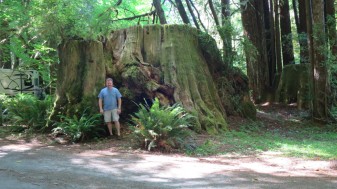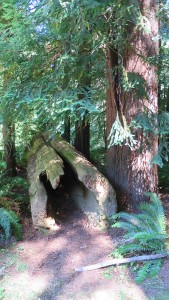 Route: CA-96W, Indian Creek Road, US-199S
Route: CA-96W, Indian Creek Road, US-199S
We got off to a relatively early start because the day’s activities included grocery shopping and laundry! We were westward bound on CA-96W until Happy Camp. We stopped at the Frontier Saloon and Cafe for second breakfast; Dave finally staged his uprising against granola and yogurt and insisted we stop. Portions were generous, food was good. Bacon was amazing – thick cut, not overly salted. Stop in if you are in town.
Our route took us through a remote area; the steep mountain slopes are not conducive to building. The road was twisty and when we crossed into Oregon, Abby earned another state badge. We debated on detouring to the Oregon Caves National Monument and Preserve, but it was 45 minutes out of our way and we needed clean undies. We turned south to Crescent City. We arrived and wanted to stop and Port O’Pints, but they didn’t open until 2. And there was no food as far as we could tell. Pre-made salad from Safeway for the lunch win!

History: Redwood logging began in 1851, as the gold rush waned. Technological advances made it easier and faster to harvest the large trees. In 1920, key groves were preserved by the State of California. In 1968, Congress created Redwood National Park, protecting the world’s tallest trees and Redwood Creek’s salmon fishery.

Coast redwoods have been recorded at 370 feet, almost 70 feet taller than the giant sequoia. There are no known killing diseases and are resistant to insects, believed to be the result of high tannin concentrations, which also provides the red hue to the wood. Fog, created by the hot air of the central valley pulling moisture laden ocean air towards the interior of CA, is key to the survival of the coastal redwood.

Redwood National and State Parks are a cooperative management effort between the National Park Service and the California Department of Parks and Recreation. Redwood National Park, Jedediah Smith Redwoods State Park, Del Norte Coast Redwoods State Park, and Prairie Creek Redwoods State Park are part of the cooperative effort and form a World Heritage Site and International Biosphere Reserve.
Campground: We stayed at Mill Creek campground in Del Norte Coast Redwoods State Park. We were lucky to get a walk-up site, number 41. Sites 40 through 42 are spaced the closest and receive the most sunlight. The sites are level and have easy access to Mill Creek. Sites 39 and 55 are prime sites, spacious and well separated from neighboring campsites. Overall, most sites in the camp well spaced. There are some tent only sites that are extremely secluded – you hike to the tent platform through a tunnel in the foliage.

Activities: Fishing in the park tributaries of the Smith River for cutthroat trout and hatchery steelhead is permitted. Mill Creek is closed to fishing part of the year. A license is required.

There are a variety of trails for hiking in the park. The Trestle Trail Loop circumvents sites 1 – 74. Off of this trail, one can access the Adler Basin, Saddler Skyline, and Hobbs Wall (via Saddler Skyline) trails. The California Coastal Trail, which is 1200 miles long, runs through the park. Also in the park is the Damnation Trail, which was used by the Tolowa Indians to reach the ocean to gather shellfish and seaweed. This trail drops 1,000 feet over two miles through old-growth redwoods and Sitka spruce. We thought about attempting this hike, but wisely did the math in advance. The average grade on the trail is 10%. We opted for the Trestle Loop Trail instead. This trail was a combination of a relatively flat and wide path (good for Alex to walk a bit) and some narrow, steep hillside hiking (good time to contain Alex in the pack).
Overall: This was a fantastic campground and would be a fantastic place to set up home base for a couple of weeks and explore the coast. There are endless day trip possibilities. Also, the proximity to Crescent City means it is easy to restock food and clean clothes.



